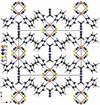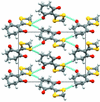issue contents
November 2022 issue

Cover illustration: 1,4,8,11-Tetraazacyclotetradecane (cyclam) is a 14-membered azamacrocycle known for its ability to form coordination compounds with transition-metal centres, and in particular with Ni2+ cations. These complexes can act as nodes for the formation of coordination polymers of different dimensionality, depending on the linkers they are combined with. The present paper describes the synthesis and crystal structure of the first one-dimensional coordination polymer based on Ni(cyclam)2+ units connected by benzene-1,3,5-tricarboxylate anions, catena-poly[[[(1,4,8,11-tetraazacyclotetradecane-κ4N1,N4,N8,N11)nickel(II)]-μ2-5-carboxybenzene-1,3-dicarboxylato-κ2O1:O3] octahydrate]. See: Gavrish, Shova & Lampeka [Acta Cryst. (2022). E78, 1122–1126].
research communications


























 journal menu
journal menu






























